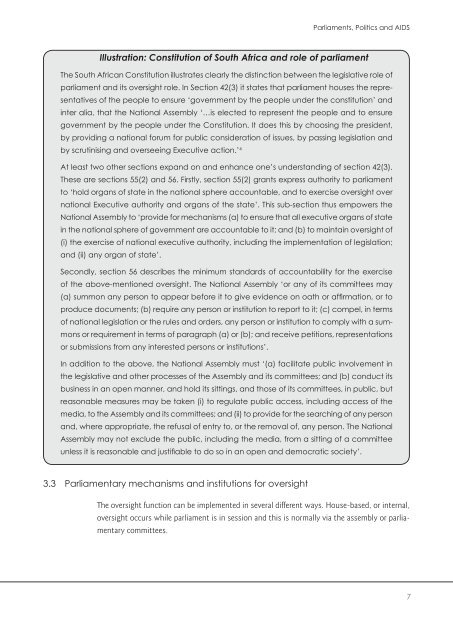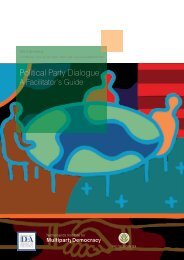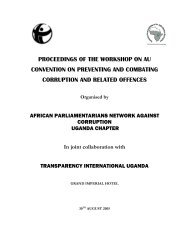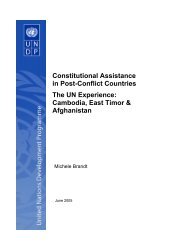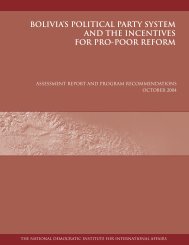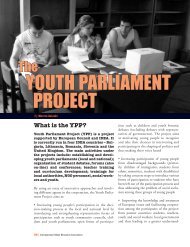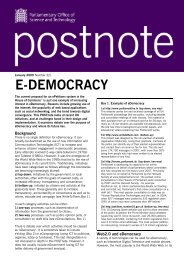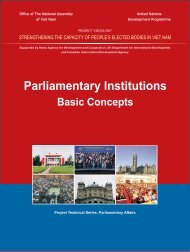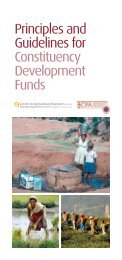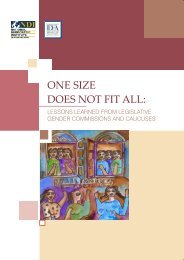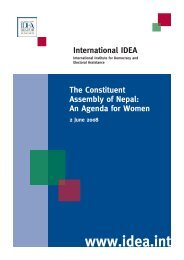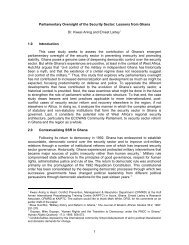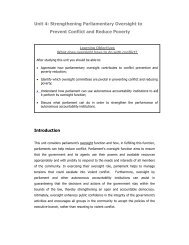Download PDF - Parliamentary Centre
Download PDF - Parliamentary Centre
Download PDF - Parliamentary Centre
- No tags were found...
Create successful ePaper yourself
Turn your PDF publications into a flip-book with our unique Google optimized e-Paper software.
Parliaments, Politics and AIDSIllustration: Constitution of South Africa and role of parliamentThe South African Constitution illustrates clearly the distinction between the legislative role ofparliament and its oversight role. In Section 42(3) it states that parliament houses the representativesof the people to ensure ‘government by the people under the constitution’ andinter alia, that the National Assembly ‘…is elected to represent the people and to ensuregovernment by the people under the Constitution. It does this by choosing the president,by providing a national forum for public consideration of issues, by passing legislation andby scrutinising and overseeing Executive action.’ 4At least two other sections expand on and enhance one’s understanding of section 42(3).These are sections 55(2) and 56. Firstly, section 55(2) grants express authority to parliamentto ‘hold organs of state in the national sphere accountable, and to exercise oversight overnational Executive authority and organs of the state’. This sub-section thus empowers theNational Assembly to ‘provide for mechanisms (a) to ensure that all executive organs of statein the national sphere of government are accountable to it; and (b) to maintain oversight of(i) the exercise of national executive authority, including the implementation of legislation;and (ii) any organ of state’.Secondly, section 56 describes the minimum standards of accountability for the exerciseof the above-mentioned oversight. The National Assembly ‘or any of its committees may(a) summon any person to appear before it to give evidence on oath or affirmation, or toproduce documents; (b) require any person or institution to report to it; (c) compel, in termsof national legislation or the rules and orders, any person or institution to comply with a summonsor requirement in terms of paragraph (a) or (b); and receive petitions, representationsor submissions from any interested persons or institutions’.In addition to the above, the National Assembly must ‘(a) facilitate public involvement inthe legislative and other processes of the Assembly and its committees; and (b) conduct itsbusiness in an open manner, and hold its sittings, and those of its committees, in public, butreasonable measures may be taken (i) to regulate public access, including access of themedia, to the Assembly and its committees; and (ii) to provide for the searching of any personand, where appropriate, the refusal of entry to, or the removal of, any person. The NationalAssembly may not exclude the public, including the media, from a sitting of a committeeunless it is reasonable and justifiable to do so in an open and democratic society’.3.3 <strong>Parliamentary</strong> mechanisms and institutions for oversightThe oversight function can be implemented in several different ways. House-based, or internal,oversight occurs while parliament is in session and this is normally via the assembly or parliamentarycommittees.


